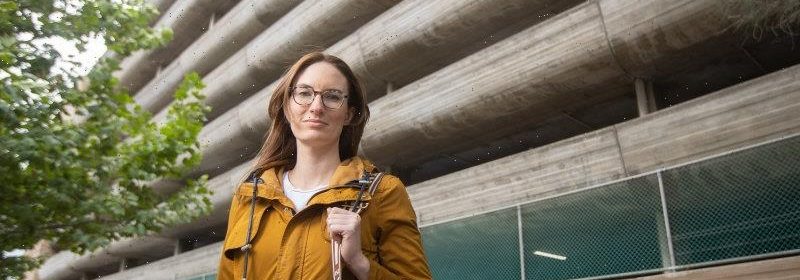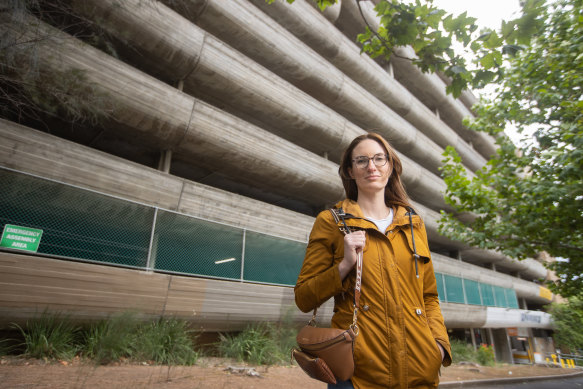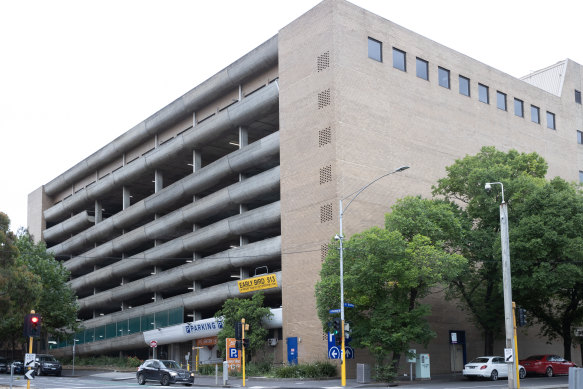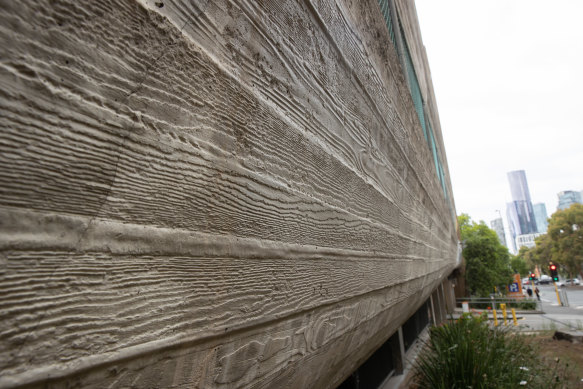Brutalist car park slated for protection. Has heritage gone too far?

Key points
- A Brutalist carpark on the corner of Grattan and Cardigan streets in Carlton is set to be heritage listed as having local aesthetic significance and representative value.
- The seven-storey concrete carpark which was for many years the Royal Women’s Hospital carpark was built in 1974 and designed by architecture firm Mockridge Stahle & Mitchell.
- Brutalism is a style of architecture characterised by minimalist constructions showcasing bare building materials and structural elements over decorative design.
Sometimes you do know what you’ve got before it’s gone: A Brutalist 1970s Carton parking lot, it turns out, is a kind of paradise – winning heritage protection despite objections from the suburb’s residents.
The City of Melbourne’s Carlton Heritage Review included the Cardigan House car park, on the corner of Grattan and Cardigan streets, due to its local aesthetic significance and representative value.
Carlton resident Katie Roberts-Hull believes the land would be better used for housing.Credit:Simon Schluter
The independent Planning Panels Victoria’s report into the review, delivered in November last year, found there was “sufficient justification” for the application of a heritage overlay to the car park.
The seven-storey concrete car park, which was for many years the Royal Women’s Hospital car park, was designed by architecture firm Mockridge Stahle & Mitchell and built in 1974.
“As a car park, it is striking, robust and bold,” the report found.
The car park was described in the Heritage Alliance’s survey of post-war built heritage in Victoria as “probably one of the most architecturally interesting examples of its type in Victoria”.
Brutalism is a style of architecture developed in the 20th century, characterised by minimalist constructions showcasing bare building materials and structural elements over decorative design.
David Wagner, president of the Victorian chapter of the Australian Institute of Architects, said Brutalist buildings were “quite direct” in how they conveyed their construction and materiality.
He said it was important to protect Brutalist buildings in order to preserve the development of architectural language.
“Some of these buildings are very sculptural and beautiful,” he said. “They are important from an embodied energy and materials perspective as well. Retaining existing structures is important from an environmental perspective.”
Wagner said the car park was “quite something” and had the strengths of geometry and rhythm which were characteristic of Brutalist architecture.
The final Carlton Heritage Review recommended that 24 new places be covered by the Heritage Overlay, including the car park.
The panel report found no evidence of unacceptable economic impacts on the community from including the heritage listing.
Cardigan House car park in Carlton.Credit:Simon Schluter
Resident Katie Roberts-Hull made submissions to the panel in which she opposed a heritage listing for the car park on the basis the land would be better used for housing.
“I would rather any other use of that site other than as a parking garage,” she said. “Heritage protection has gone way too far. So much of Carlton is heritage protected, so it is hard for families like mine to move into the area.”
Roberts-Hull said the panel was sympathetic to her argument but she got the sense that what heritage consultants said was more important than any other consideration.
“Some buildings are definitely worth protecting but once we have more than 50 per cent of land locked up in the inner city, there are broader issues,” she said.
“As Melbourne gets set to be the biggest city in Australia, where are people going to live? Heritage protection leads to more greenfield sprawl and more people reliant on their cars as they have to live in outer suburbs with poor public transport.”
Resident Scott Campbell said he did not understand why the car park would get heritage protection.
“I wouldn’t really heritage list something like this, It doesn’t seem all that old,” he said. “It’s pretty grey, there’s not much more to it. There’s just a lot of cement.”
However, resident Shaun Yue said the car park deserved protection.
“Concrete is not particularly eye-pleasing, but when you look at it closely you can see that it is made out of pressing concrete to wood, so it is a really interesting technique where they have tried to make the concrete a little bit more palatable,” he said.
A closer inspection of the surface of the car park’s concrete walls reveals the fine detail in its design.Credit:Simon Schluter
“It is a very specific type of architecture from a very specific time and if you tear everything down that is not fashionable right now you end up with glass and concrete boxes.”
Madeleine Moore, acting manager of advocacy for Victoria at the National Trust of Australia, said Brutalist architecture was divisive.
“Some are put off by its monumentality and negative associations with political movements,” she said. “However many are drawn to the strong aesthetics of Brutalism.”
Moore said in Melbourne the protection of post-war architecture was a big issue.
The Cardigan House car park is not Melbourne’s only car park considered worthy of heritage protection. The Total House car park and Melbourne University Underground car park are both on the Victorian Heritage Register.
The Carlton car park is owned by the Royal Women’s Hospital, which moved from Carlton to Parkville in 2008. A spokeswoman for the hospital declined to comment on the potential heritage listing.
The next step in heritage protection for the car park is for the Carlton Heritage Review to be considered by the City of Melbourne this year.
A spokeswoman for the City of Melbourne said the council was carefully considering the findings of the planning panel and would make a recommendation in the coming months.
“We look forward to the completion of this review and planning scheme amendment process – so that heritage protection in one of Melbourne’s oldest and most vibrant suburbs is updated in line with community expectations and expert analysis,” she said.
Melbourne’s historic car parks
- Melbourne University Underground Car park. Built in 1972 and famously used in the Mad Max film, it features two Atlas figures at its entrance from the demolished Colonial Bank. Designed by architectural firm Loder and Bayly in association with Harris, Lange and Partners.
- Total Car park. Corner of Russell and Little Bourke streets. Built in 1965, the car park looks like a stack of seven floating concrete decks, topped with an old-fashioned television set. It is listed on the Victorian Heritage Register.
- Victoria Car park. 103-107 Russell Street. Built in 1938, this was Victoria’s first commercial car park and Melbourne’s first multi-level car park. Designed with art deco facades, the facades were retained but the rest demolished.
- Golden Square Car park. 225-231 Lonsdale Street. Built in 1955 and designed by Bernard Evans & Associates for Myer.
The Morning Edition newsletter is our guide to the day’s most important and interesting stories, analysis and insights. Sign up here.
Most Viewed in National
From our partners
Source: Read Full Article



